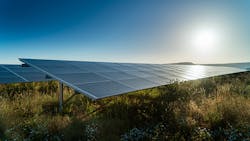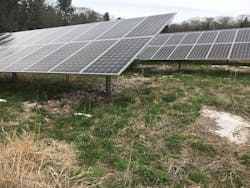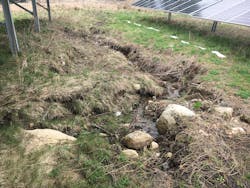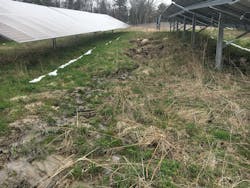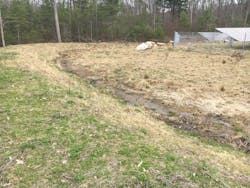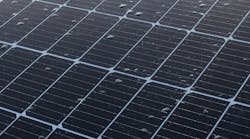Over the last decade, large-scale solar electric generation installations have grown by a factor of more than 250 in the United States, according to Solar Energy Industry Association data—from just 266 megawatts of utility and non-residential capacity to more than 75,000 megawatts by the end of this year (SEIA, 2020).
While the solar revolution has proven overall a boon for the environment, offsetting millions of tons of carbon dioxide emissions by replacing coal, oil, and natural gas for electric generation, one challenge posed is stormwater management. In this article, we will discuss projects we’ve worked on to illustrate some of the challenges and solutions associated with the stormwater management of solar array developments both during and after the construction phase.
At a high level, the main stormwater issue associated with solar arrays is the concentrated discharge of stormwater runoff at the solar panel drip line, which can act like un-guttered roofs that channelize and accelerate stormwater flow. Instead of traveling as sheet flow across a fallow field, capped landfill, or macadamized parking area, stormwater now lands on the surface in channelized sheets that must be carefully managed to prevent soil scouring, erosion, and contamination and protect stormwater management systems from becoming overwhelmed with excessive runoff flow or sediment accumulation.These concerns are especially significant when the ground surface is a capped landfill that is undergoing a “brownfield to brightfield” conversion through being reused for solar generation deployment. This is one of the most popular and successful approaches to large-scale solar development in the US because it solves two problems at once: land utilization and revenue generation at properties that could not otherwise be redeveloped with buildings for other commercial uses because of environmental conditions and/or settlement and soil instability associated with biological degradation and consolidation of the buried waste. Given these site development challenges associated with landfill redevelopment, harnessing the economies of scale and efficiencies to site thousands of solar panels in one large location is a favorable and beneficial re-use for former landfill facilities.
For a brownfield site like a former landfill undergoing long-term remediation, installing solar power also can be a positive, revenue-generating interim use for communities and property owners because solar arrays can be implemented without significantly disturbing landfill cap systems, the array components can tolerate long term differing levels of settlement of subgrade materials, and they can be easily disassembled and removed from the property and recycled.Without a properly designed stormwater management system and soil erosion and sediment control plan that adheres to best management practices, solar installations risk creating intensified surface flows from rainwater that can destabilize landfill cap systems, expose underlying waste, and transport contaminated solids. Environmentally regulated sites such as closed landfills often need a post-closure use permit or similar regulatory approval, as well as NPDES permits specifically covering the construction phase.
At the former Coventry Landfill in Coventry, RI, where we designed and constructed a landfill cap to accommodate a future solar power generation facility, the key was the use of a system called ClosureTurf, created and patented by Watershed Geo. ClosureTurf is an impervious cover system that includes a synthetic turf component. The use of the ClosureTurf cap system to furnish the Site’s final cover eliminates the possibility of future cap erosion and unwanted vegetation through the solar array area. This is a three-component system that includes an impermeable geomembrane, an engineered synthetic turf, and a specified infill on top.
Several design factors contributed to selecting ClosureTurf as the final closure system for this project. When compared to a conventional landfill cap, which utilizes low permeable soil and vegetated final surfaces, ClosureTurf met the closure design objective and decreased construction duration, which reduced construction costs associated with soil erosion and sediment transport. The system allowed for the cap subgrade soils to be covered quickly with geosynthetic products, eliminating precipitation from coming in contact with underlying soils. It also significantly reduced earthwork activities and the time for the establishment of final vegetation. In post-closure, the system reduces cap soil erosion and long-term operation and maintenance costs for vegetation management and cap repairs.We’ve also had experience working to remediate stormwater problems at existing solar power generation facilities after installation and commissioning. Most problems are associated with post-construction soil erosion and poor vegetation establishment, due to the lack of implementing temporary erosion controls and other best management practices during construction and over compaction of topsoil layers.
Typically, soils under the solar panel edges were not properly stabilized (via vegetation, crushed stone, or sediment and erosion control devices), and the concentrated flow at the drip edges of the panel caused scour and erosion of vegetated surfaces and/or topsoil to occur. Sediment can be transported to perimeter stormwater BMPs, which can reduce infiltration capacity and hydraulic performance of the systems, causing downgradient flooding and sediment transport.
Remedial measures and corrective actions included:
- excavation of sediment from the bottom of stormwater BMPs;
- filling and fine grading in areas scoured by channelized flow throughout the solar array;
- addition of rip rap inlets and sediment forebays to stormwater BMPs to trap sediment upgradient of permanent BMP’s;
- soil augmentation and hydroseeding of turfgrass (most effective if sites are seeded in the spring or the fall);
- scarification of the bottoms of stormwater BMP’s to re-establish the infiltration capacity—reducing sediment buildup on the bottom of ponds to improve infiltration and overall hydraulic performance; and
- installation of temporary erosion controls (mulch, silt fence, straw wattles, compost logs, surface netting) to reduce runoff velocity, prevent erosion of topsoil, and promote vegetation growth.
Most regulatory agencies allow designers to use the drainage characteristics of the vegetated surface under the panels if it has been properly stabilized. The panels are not considered the ground surface, as the water runs off the panel onto the surface below (as opposed to a building, which does not allow stormwater to contact the surface below the roof).
Over a grass meadow, 30 to 80% of rainfall runs off from the ground surface (per USDA TR-55). Over bare soil, 77 to 94% of rainfall runs off from the ground surface (per USDA TR-55). This makes establishing and maintaining vegetation and implementing robust soil erosion and sediment control plan a priority for solar development projects. Note that if solar panels use ballast block footings, the footing area should be considered impervious (100% runoff).
Lessons Learned
To sum up, five of the biggest lessons we’ve learned for how stormwater management professionals can best support solar project developers:
- Make sure solar clients understand, budget, and design for the stormwater challenges that solar arrays create.
- Ensure the construction schedule and sequencing will allow for vegetation to establish and avoid sequencing the project in a manner that causes heavy equipment to travel over topsoil and established vegetation.
- Raise awareness from the beginning among subcontractors and employees about the importance of implementing the soil erosion and sediment control plan. Be diligent about maintaining the systems and operating equipment on the site in ways that avoid soil rutting, soil erosion, and negative impacts on sediment controls.
- Monitor topsoil compaction and erosion continually over time and be sure to follow best management practices for protecting vegetation as it germinates.
- In the case of a former landfill or other significantly contaminated brownfield sites, the added cost of installing an engineered membrane cover may be a cost-effective remedial option depending on the site characteristics and overall remedial objectives.
Solar power has taken off as an energy and environmental solution in the US because of its ever-increasing efficiency in harnessing the power of the sun. Understanding and managing the power of the rain, and what it means for stormwater impacts, is also critically important to successful solar energy development.
References
Solar Energy Industries Association (SEIA). Solar Industry Research Data. www.seia.org/solar-industry-research-data. Accessed 07/31/2020.
United States Department of Agriculture. Technical Release 55: Urban Hydrology for Small Watersheds. 2nd ed. 1986. www.wcc.nrcs.usda.gov/ftpref/wntsc/H&H/other/TR55documentation.pdf
About the Author
Ryan DaPonte
Ryan DaPonte is a civil engineer based in the Providence, RI, office of GZA GeoEnvironmental Inc., a leading multi-disciplinary firm providing geotechnical, environmental, ecological, water, and construction management services.
Todd Greene
Todd Greene is an associate principal, based in the Providence, RI, office of GZA GeoEnvironmental Inc., a leading multi-disciplinary firm providing geotechnical, environmental, ecological, water, and construction management services.
Nichole Murawski
Nichole Murawski is a civil engineer based in the Providence, RI, office of GZA GeoEnvironmental Inc., a leading multi-disciplinary firm providing geotechnical, environmental, ecological, water, and construction management services.
